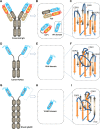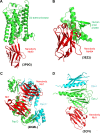Nanobody-derived nanobiotechnology tool kits for diverse biomedical and biotechnology applications
- PMID: 27499623
- PMCID: PMC4959585
- DOI: 10.2147/IJN.S107194
Nanobody-derived nanobiotechnology tool kits for diverse biomedical and biotechnology applications
Abstract
Owing to peculiar properties of nanobody, including nanoscale size, robust structure, stable and soluble behaviors in aqueous solution, reversible refolding, high affinity and specificity for only one cognate target, superior cryptic cleft accessibility, and deep tissue penetration, as well as a sustainable source, it has been an ideal research tool for the development of sophisticated nanobiotechnologies. Currently, the nanobody has been evolved into versatile research and application tool kits for diverse biomedical and biotechnology applications. Various nanobody-derived formats, including the nanobody itself, the radionuclide or fluorescent-labeled nanobodies, nanobody homo- or heteromultimers, nanobody-coated nanoparticles, and nanobody-displayed bacteriophages, have been successfully demonstrated as powerful nanobiotechnological tool kits for basic biomedical research, targeting drug delivery and therapy, disease diagnosis, bioimaging, and agricultural and plant protection. These applications indicate a special advantage of these nanobody-derived technologies, already surpassing the "me-too" products of other equivalent binders, such as the full-length antibodies, single-chain variable fragments, antigen-binding fragments, targeting peptides, and DNA-based aptamers. In this review, we summarize the current state of the art in nanobody research, focusing on the nanobody structural features, nanobody production approach, nanobody-derived nanobiotechnology tool kits, and the potentially diverse applications in biomedicine and biotechnology. The future trends, challenges, and limitations of the nanobody-derived nanobiotechnology tool kits are also discussed.
Keywords: HCAbs; IgNAR; V-NAR; VHH; nanobiotechnology; nanobody.
Figures



References
-
- Muyldermans S. Nanobodies: natural single-domain antibodies. Annu Rev Biochem. 2013;82:775–797. - PubMed
-
- De Meyer T, Muyldermans S, Depicker A. Nanobody-based products as research and diagnostic tools. Trends Biotechnol. 2014;32(5):263–270. - PubMed
-
- Saerens D, Muyldermans S. Single Domain Antibodies: Methods and Protocols. Totowa, NJ: Humana Press; 2012.
Publication types
MeSH terms
Substances
LinkOut - more resources
Full Text Sources
Other Literature Sources

